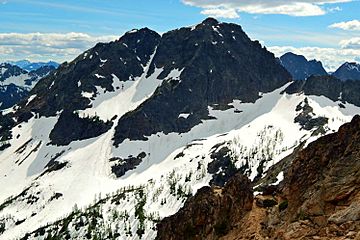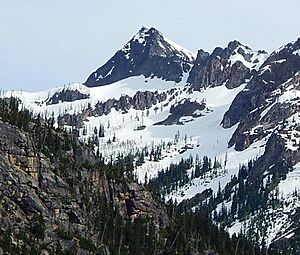Copper Benchmark facts for kids
Quick facts for kids Copper Benchmark |
|
|---|---|

Copper Benchmark seen from Wallaby Peak
|
|
| Highest point | |
| Elevation | 7,840 ft (2,390 m) } |
| Prominence | 1,169 ft (356 m) |
| Isolation | 0.9 mi (1.4 km) |
| Geography | |
| Parent range | North Cascades |
| Topo map | USGS McAlester Mountain |
| Climbing | |
| Easiest route | Scrambling class 3 |
Copper Benchmark, also known as Copper Point, is a mountain peak. It is found in the Methow Mountains. These mountains are part of the larger North Cascades range. The peak sits on the border between Okanogan County and Chelan County in Washington state.
Copper Benchmark is located on the top ridge of the Cascade Range. It is between Kangaroo Pass and Copper Pass. Long ago, it was used as a triangulation station. This helped early surveyors map the land accurately. The mountain is protected within the Lake Chelan-Sawtooth Wilderness. This wilderness area is part of the Okanogan National Forest.
A smaller peak called Pica Peak is nearby. It is about 0.52 miles (0.84 km) northwest of Copper Benchmark. Pica Peak is 7,565 feet (2,306 meters) tall. The closest taller peak is Wallaby Peak, which is 0.9 miles (1.4 km) to the northeast. Water from the north side of Copper Benchmark flows into the Methow River. This happens through a stream called Early Winters Creek. Water from other sides of the mountain flows into streams that feed the Chelan River.
Weather at Copper Benchmark
Copper Benchmark is in a marine west coast climate zone. This means it has mild, wet winters and cool, dry summers. Most of the weather systems start over the Pacific Ocean. They then travel northeast towards the Cascade Mountains.
As these weather systems reach the North Cascades, the tall peaks force the air upwards. This process is called Orographic lift. When the air rises, it cools down. This causes the moisture in the air to turn into rain or snow. Because of this, the western side of the North Cascades gets a lot of rain and snow. This is especially true during the winter months. In winter, it's often cloudy. But in summer, high-pressure systems over the Pacific Ocean bring clear skies.
How the Mountains Formed
The North Cascades have very rugged land. You can see sharp peaks, long ridges, and deep valleys carved by glaciers. These different shapes and big changes in height were created by geological events. These events happened millions of years ago. They also led to the different climates across the Cascade Range.
The Cascade Mountains started forming millions of years ago. This was during the late Eocene Epoch. The North American Plate is a huge piece of Earth's crust. It slowly moved over the Pacific Plate. This movement caused many volcanic eruptions.
Also, small pieces of the Earth's crust, called terranes, joined together. These pieces came from both the ocean floor and continents. They helped form the North Cascades about 50 million years ago.
During the Pleistocene period, which was over two million years ago, glaciers played a big role. Huge sheets of ice moved forward and then melted back many times. As they moved, they scraped the land. This left behind piles of rock and debris. The valleys in the area have a "U" shape. This shape was created by these recent glaciers.
The tall peaks and deep valleys of the North Cascades were mainly formed by two processes. These are uplift (when land is pushed up) and faulting (when cracks form in the Earth's crust). These processes, combined with the action of glaciers, shaped the amazing landscape we see today.





